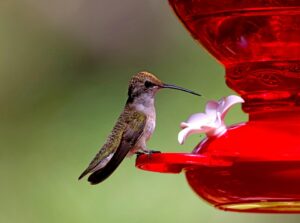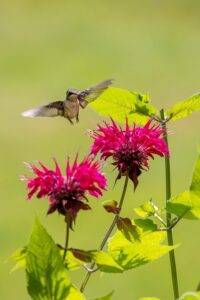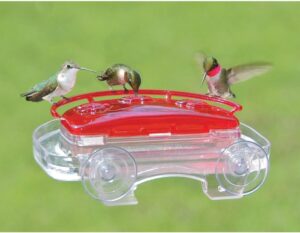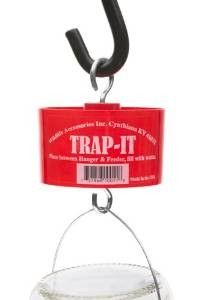How to Choose the Best Place to Hang a Hummingbird Feeder: A Complete Guide
If you’re looking to attract hummingbirds to your garden or backyard, hanging a hummingbird feeder is one of the most effective ways to do it.  These tiny, colorful birds are drawn to nectar, and offering them a feeding station can bring a lively and beautiful element to your outdoor space. However, the placement of your hummingbird feeder is crucial to its success. Choosing the right spot ensures that the birds will find it, feel safe while feeding, and return regularly.
These tiny, colorful birds are drawn to nectar, and offering them a feeding station can bring a lively and beautiful element to your outdoor space. However, the placement of your hummingbird feeder is crucial to its success. Choosing the right spot ensures that the birds will find it, feel safe while feeding, and return regularly.
In this comprehensive guide, we’ll walk you through the key factors to consider when deciding where to hang a hummingbird feeder. From considering the birds’ natural habits to ensuring their safety and comfort, we’ll cover everything you need to know to make your hummingbird feeder a buzzing success.
1. Why Placement Matters for Your Hummingbird Feeder
Before diving into the specifics of choosing a location, it’s essential to understand why placement matters. Proper positioning can make all the difference in attracting hummingbirds. Poor placement may result in the birds not discovering the feeder, feeling unsafe, or encountering environmental hazards.
Here’s why the right place matters:
- Attracts Hummingbirds: Hummingbirds are naturally drawn to bright, vibrant colors (especially red), but the feeder’s location plays a key role in ensuring they can find it easily.
- Safety: If the feeder is placed in a place that’s too exposed to predators or harsh weather, hummingbirds may avoid it.
- Feeding Comfort: Hummingbirds prefer a peaceful, low-stress environment when feeding, so they need a place that feels safe and isn’t too windy or bustling.
Now let’s dive into the specific factors that influence the ideal spot for your hummingbird feeder.
2. Factors to Consider When Choosing a Location for Your Hummingbird Feeder
Discover the essential steps for hanging your hummingbird feeder with our comprehensive guide! This step-by-step video tutorial covers everything you need to know about selecting the right location, proper hanging techniques, and tips for attracting these delightful birds. Learn the best practices to make your yard a hummingbird haven. Watch now and enjoy the beauty of hummingbirds visiting your feeder!
2.1. Sunlight Exposure
Hummingbirds need the warmth of the sun to help them maintain their energy levels, and a feeder placed in a sunny spot will be more inviting. However, there are a few important things to consider:
- Partial Sun: While direct sunlight can be beneficial for the birds, placing the feeder in full, unshaded sunlight all day can cause the nectar to spoil quickly. Direct sunlight also heats up the feeder, which may deter the birds.
- Shaded Areas: Some shade is helpful for the birds, as it can offer them relief from intense heat. However, avoid too much shade, as it can cause the nectar to cool and become less appealing to the birds.
- Morning Sun: A good option is to place the feeder in a spot that gets morning sunlight. This will ensure the nectar warms up early, attracting the birds in the cooler hours of the day without the risk of it spoiling in the afternoon heat.
2.2. Accessibility
It’s important to place your hummingbird feeder where it’s easily accessible to the birds, but also where you can easily refill and clean it. Think about the following:
- Easy Viewing: Place your feeder in a location where you can watch the birds, such as near a window or on a patio. This lets you enjoy the spectacle without disturbing the birds.
- Height: Ideally, place the feeder about 5 to 6 feet off the ground. This height provides a good balance between accessibility for both the birds and yourself for maintenance.
- Visibility: Hummingbirds rely on their keen eyesight to find food. Ensure the feeder is placed in a clear area without too much clutter around it, such as near trees or bushes, which could obscure the birds’ view.
2.3. Protection from Predators
Predators such as cats, squirrels, and other wildlife may view the hummingbird feeder as an easy food source. To prevent such issues:
- Avoid Ground-Level Placement: Place the feeder above the ground to make it more difficult for predators to reach.
- Hang the Feeder Away from Tree Branches: Cats, in particular, can jump from tree branches and other elevated surfaces. Hanging the feeder away from these potential launch points helps protect the birds.
- Use Predator-Proof Hummingbird Feeders: Some hummingbird feeders are designed with features to deter unwanted visitors, such as built-in squirrel baffles or ant moats.
2.4. Wind Protection
Hummingbirds are small and lightweight, so strong winds can be problematic for them. If the feeder sways or is placed in an area with heavy wind, the birds might avoid it.
- Look for Shelter: Place the feeder in a location that’s sheltered from strong winds, such as near a building, fence, or tree.
- Avoid Windy Corners: Be cautious of placing the feeder in open areas that might get gusty, such as at the edge of a property or near wind tunnels.
- Sturdy Mounting: Ensure that your feeder is securely mounted or hung, so it doesn’t sway excessively in the wind. A sturdy hook or pole is a good choice.
2.5. Proximity to Flowers

Hummingbirds are naturally attracted to flowering plants rich in nectar. Consider placing the feeder near flowering plants that hummingbirds
favor, such as:
- Trumpet Vine
- Bee Balm
- Fuchsia
- Salvia
- Columbine
By placing the feeder near these plants, you create an inviting habitat that mimics the hummingbirds’ natural foraging environment. They’ll be more likely to visit your feeder if they also find their favorite flowers nearby.
Here’s a complete guide to attracting hummingbirds to your yard. It lists plants, vines and shrubs that are in bloom for spring, summer and fall. Your hummingbirds will always have flower nectar to feed on.
2.6. Avoid High-Traffic Areas
While you want the hummingbirds to feel safe, it’s equally important to ensure that the feeder is placed away from areas with a lot of human or animal activity. Hummingbirds can be easily startled, so avoid placing the feeder in busy spots like:
- Near Active Pathways: If people are frequently walking by, the birds may feel threatened and avoid the feeder.
- Around Noisy Areas: Areas with loud machinery, like near an air conditioning unit or power tools, could be off-putting for hummingbirds, who prefer peaceful surroundings.
2.7. Distance from Windows
While hanging a hummingbird feeder near a window can offer great viewing opportunities, it’s important to prevent collisions with the glass. Hummingbirds are known to occasionally fly into windows due to their fast speeds and inability to recognize the glass. To avoid this:
- Use Window Decals: If you must place the feeder near a window, use decals or other window treatments to make the glass more visible.
- Place Feeder at a Safe Distance: If possible, hang the feeder at least 3 to 4 feet from any windows to reduce the risk of collisions.
Window feeder for a close up viewing area
Experience the thrill of watching hummingbirds up close as they hover right outside your window. With a hummingbird window feeder!

Having a hummingbird window feeder brings the excitement of nature right to your window. Imagine watching these vibrant, tiny birds hover just inches away as they sip nectar. Their iridescent feathers glisten in the light, and their rapid wing beats create a mesmerizing display you can enjoy from the comfort of your home. It’s a truly unique and personal experience, offering a front-row seat to nature’s most agile acrobats.
What makes a hummingbird window feeder even more thrilling is how often these fascinating creatures visit. You’ll get to see them return throughout the day, sometimes making multiple stops at your feeder. Each visit is a new opportunity to observe their graceful movements and learn more about these incredible birds. It’s like having your own live wildlife show right outside your window!
Beyond the joy of bird watching, a hummingbird window feeder adds a burst of color and life to your space. Whether you’re relaxing indoors or enjoying a cup of coffee, the sight of these dazzling creatures brings a touch of serenity and beauty to your day. It’s a simple, yet unforgettable way to connect with nature without leaving home.
3. How to Hang the Feeder
Once you’ve selected the perfect location, it’s time to hang the feeder. Here are some tips to make sure it stays secure:
- Use a Strong Hook: Choose a hook or a pole that is strong enough to support the weight of the feeder, especially if it’s filled with nectar. A metal shepherd’s hook or a stable branch can work well.
- Adjust the Height: Ensure the feeder is placed at a comfortable height for both the birds and for you. 5 to 6 feet is ideal for maintenance and viewing.
- Check Stability: Make sure the feeder is stable and doesn’t sway too much in the wind. A secure feeder will help keep the birds coming back.
4. Maintaining Your Hummingbird Feeder Location
Finally, after the feeder is in place, it’s important to maintain the area to keep the hummingbirds safe and the nectar fresh:
- Regular Cleaning: Clean the feeder every 2 to 3 days to prevent mold or bacteria buildup, especially during hot weather.
- Refill as Needed: Keep the nectar levels topped up, particularly during peak feeding hours, which are often early morning and late afternoon.
- Monitor for Pests: Watch out for ants, bees, or other pests that may invade the feeder. Consider using an ant moat or other natural deterrents to keep them at bay.
Guide for when to change the nectar
Letting the nectar ferment encourages mold growth, which makes the cleaning process more difficult. To avoid this, follow the chart below for recommended nectar changes based on the temperature. The hotter it gets, the more frequently you’ll need to replace the nectar.
High temperatures…………Change after
71-75……………………………6 days
76-80……………………………5 days
81-84……………………………4 days
85-88……………………………3 days
89-92……………………………2 days
93+………………………………change daily
Click on the link for a detailed guide to help you clean your hummingbird feeder, especially when mold starts to grow due to nectar not being changed in time.
If you already have a hummingbird feeder, and you want to protect it from ants and other crawling insects, the ant moat below will do the job.
Trap-It Ant Moat for Hummingbird Feeders
Using an ant moat for your hummingbird feeder is an effective way to keep ants away from the sweet nectar. These tiny creatures are drawn to

the sugar water, and without a barrier, they will quickly infest your feeder, preventing the birds from enjoying the nectar. An ant moat works by creating a barrier of water that ants can’t cross. Positioned above the feeder, it effectively blocks the ants’ path, keeping them from reaching the nectar.
This simple solution also ensures that your hummingbird feeder remains clean and accessible for the birds, rather than becoming a breeding ground for ants or other pests. It’s a small addition that can make a big difference in maintaining a healthy, inviting space for hummingbirds, while also reducing the need for chemical ant deterrents.
The first and still the best to protect your Hummingbird and Oriole feeder from ants and other crawling insects. Insert between hanger and feeder and fill with water, providing a barrier to crawling pests. Red color to attract hummingbirds.
5. Conclusion
Hanging a hummingbird feeder is a fantastic way to attract these fascinating birds to your yard. However, choosing the right location is key to ensuring that the birds feel safe, comfortable, and encouraged to visit regularly. By considering factors such as sunlight exposure, predator protection, wind shelter, and accessibility, you can create the perfect environment for your feathered friends.
Take the time to find the ideal spot for your feeder, and you’ll be rewarded with the enchanting sight of hummingbirds flitting around your garden, adding color and life to your outdoor space.
Happy birdwatching!
If you found this article helpful please share it with your friends using the social bookmarking buttons on the left side of this page. Help everyone to increase their enjoyment of feeding hummingbirds. Do it for the hummingbirds!
Hummingbird Resources
U.S. Fish and Wildlife Service – Hummingbird Conservation
This site offers detailed information about various hummingbird species, their habitats, and conservation efforts. It also provides resources on how to protect these fascinating birds.
National Park Service – Hummingbird Resources
The National Park Service offers insights into hummingbird species found in national parks, their behaviors, and their role in ecosystems, along with tips for observing them.
Smithsonian National Museum of Natural History – Birds: Hummingbirds
This resource provides educational materials on the role of hummingbirds in pollination and biodiversity, backed by scientific research and exhibits from the Smithsonian.

